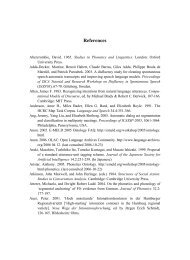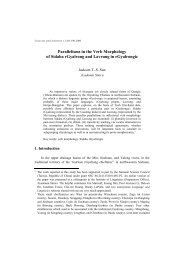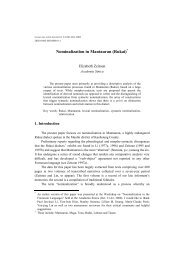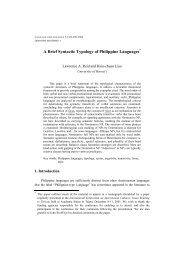Loanwords from English to Malay in the Field of Mathematics*
Loanwords from English to Malay in the Field of Mathematics*
Loanwords from English to Malay in the Field of Mathematics*
Create successful ePaper yourself
Turn your PDF publications into a flip-book with our unique Google optimized e-Paper software.
<strong>Loanwords</strong> <strong>from</strong> <strong>English</strong> <strong>to</strong> <strong>Malay</strong> <strong>in</strong> <strong>the</strong> <strong>Field</strong> <strong>of</strong> Ma<strong>the</strong>matics<br />
The chi-squared test statistic for <strong>the</strong> s<strong>in</strong>gle-word loanword data comes <strong>to</strong> 21.59,<br />
yield<strong>in</strong>g a p-value <strong>of</strong> 0.0014. This <strong>in</strong>dicates that <strong>the</strong>re is strong evidence <strong>of</strong> a significant<br />
difference <strong>in</strong> <strong>the</strong> tendencies for <strong>the</strong> ma<strong>the</strong>matics books <strong>to</strong>wards different types <strong>of</strong><br />
s<strong>in</strong>gle-word loanwords.<br />
For <strong>the</strong> compound loanword data, <strong>the</strong> test statistic comes <strong>to</strong> 9.487, yield<strong>in</strong>g a<br />
p-value <strong>of</strong> 0.148. This means that our study uncovered no evidence <strong>of</strong> a difference<br />
between <strong>the</strong> four subject matters <strong>in</strong> terms <strong>of</strong> <strong>the</strong>ir tendencies <strong>to</strong>wards different types <strong>of</strong><br />
compound loanwords.<br />
For <strong>the</strong> s<strong>in</strong>gle-word loanwords, we can discover more about <strong>the</strong> tendencies by<br />
exam<strong>in</strong><strong>in</strong>g <strong>the</strong> percentages <strong>of</strong> different types <strong>of</strong> s<strong>in</strong>gle-word loanwords (Table 3). The<br />
Calculus and Analysis books had higher percentages <strong>of</strong> non-loanwords and semantic<br />
extensions than <strong>the</strong> Algebra and Statistics books, <strong>the</strong> Statistics book had a much lower<br />
proportion <strong>of</strong> Orthographically Assimilated loanwords, and <strong>the</strong> Algebra book a much<br />
higher one.<br />
Table 3: Percentages <strong>of</strong> various s<strong>in</strong>gle-loanword types for <strong>the</strong> four ma<strong>the</strong>matics<br />
textbooks<br />
Algebra Calculus Analysis Statistics Overall<br />
Non-loanwords or<br />
Semantic Extensions<br />
42% 64% 70% 44% 56%<br />
Orthographically<br />
Assimilated <strong>Loanwords</strong><br />
50% 21% 15% 6% 25%<br />
O<strong>the</strong>rs 8% 14% 15% 50% 20%<br />
The data for ma<strong>the</strong>matical terms (overall) versus general terms is shown <strong>in</strong> Table 4<br />
(s<strong>in</strong>gle-word loanwords) and Table 5 (compound loanwords).<br />
Table 4: S<strong>in</strong>gle-word loanword frequencies for ma<strong>the</strong>matical terms and for<br />
general Language<br />
General<br />
Terms<br />
Ma<strong>the</strong>matical<br />
Terms<br />
Total<br />
Orthographically Assimilated<br />
<strong>Loanwords</strong><br />
643 20 663<br />
Unassimilated <strong>Loanwords</strong> 1211 7 1218<br />
Partially or Wholly<br />
Assimilated <strong>Loanwords</strong><br />
596 5 601<br />
O<strong>the</strong>rs 159 4 163<br />
Grand Total 2609 36 2645<br />
67










